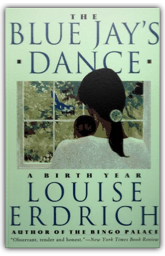
Mothers often cling to single moments, small gestures, and specific memories in order to grasp all that happens in the first blurry year of a baby's life. In The Blue Jay's Dance, writer Louise Erdrich has assembled a photo album of snapshots such as these: the days and images that collectively define the passion, ambivalence, yearnings, and satisfactions of carrying, birthing, and nurturing a baby. "Any sublime effort has its dark moments," says Erdrich, referring to a rather bleak snapshot of mother isolation. "Perhaps, if anything, the meaning in this book for others may be this: Here is a job in which it is not unusual to be, at the same instant, wildly joyous and profoundly stressed." The Blue Jay's Dance is a fresh and masterful book that avoids all the sticky clichés while still managing to articulate the depths of mother-baby love. 
Renowned artist M.C. Escher is not a surrealist drawing us into his dream world, but an architect of perfectly impossible worlds who presents the structurally unthinkable as though it were a law of nature. Weird, beautiful, finely detailed illusions. 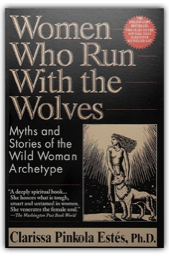
"A deeply spiritual book...She honors what is tough, smart and untamed in women. She venerates the female soul." 
Jane is neither the youngest nor the oldest, and so she calls herself the middle Moffat. And she's always in the middle of all the fun, whether it's a fast and furious card game with the oldest inhabitant of Cranbury, or playing the old pump organ and blowing out moths instead of music, or losing her head in the middle of the school play. Being a Moffat is exciting and full of laughs whatever age you are! 
Who else but a member of the Moffat family could, during kindergarten recess, accidentally hitch a ride out of town on a boxcar? Or wind up trapped in the breadbox outside the delicatessen store? Or kindly offer to escort the Salvation Army man to his destination—only to accidentally bump him out of his own horse-drawn wagon? The Moffats is a paradigm of old-fashioned family fun. Four children and a hard-working widowed mother live together on New Dollar Street in the village of Cranbury. Their seemingly quiet lives are studded with almost daily unexpected adventures, with droll results. 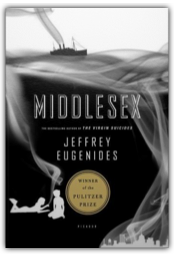
"I was born twice: first, as a baby girl, on a remarkably smogless Detroit day in January of 1960; and then again, as a teenage boy, in an emergency room near Petoskey, Michigan, in August of 1974." And so begins Middlesex, the mesmerizing saga of a near-mythic Greek American family and the "roller-coaster ride of a single gene through time." The odd but utterly believable story of Cal Stephanides, and how this 41-year-old hermaphrodite was raised as Calliope, is at the tender heart of this long-awaited second novel from Jeffrey Eugenides, whose elegant and haunting 1993 debut, The Virgin Suicides, remains one of the finest first novels of recent memory. 
In the tradition of Bright Lights, Big City and The Secret History comes a compelling, highly-acclaimed debut novel of youth and innocence. On the elm-lined streets of a middle-class American city, the lives of a group of teenaged boys are forever changed by their obsession with five mysteriously doomed sisters. |

Girls Will Be Boys is a collection of reports by women about men in rock. With pieces on Bon Jovi, Blur, Oasis, The Charlatans, The Manic Street Preachers, Motorhead, and Happy Mondays, rap lyrics, and house music, as well as Courtney Love, Sinead O’Connor, Bjork, and the riot grrls, Girls Will Be Boys provides some of the most insightful and cutting-edge contributions to rock’s literary tradition. 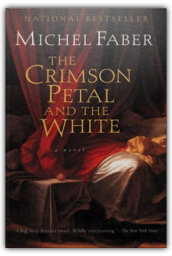
Although it's billed as "the first great 19th-century novel of the 21st century," The Crimson Petal and the White is anything but Victorian. The story of a well-read London prostitute named Sugar, who spends her free hours composing a violent, pornographic screed against men, Michel Faber's dazzling second novel dares to go where George Eliot's The Mill on the Floss and the works of Charles Dickens could not. We learn about the positions and orifices that Sugar and her clients favor, about her lingering skin condition, and about the suspect ingredients of her prophylactic douches. Still, Sugar believes she can make a better life for herself. When she is taken up by a wealthy man, the perfumer William Rackham, her wings are clipped, and she must balance financial security against the obvious servitude of her position. The physical risks and hardships of Sugar's life (and the even harder "honest" life she would have led as a factory worker) contrast—yet not entirely—with the medical mistreatment of her benefactor's wife, Agnes, and beautifully underscore Faber's emphasis on class and sexual politics. In theme and treatment, this is a novel that Virginia Woolf might have written, had she been born 70 years later. The language, however, is Faber's own—brisk and elastic—and, after an awkward opening, the plethora of detail he offers (costume, food, manners, cheap stage performances, the London streets) slides effortlessly into his forward-moving sentences. When Agnes goes mad, for instance, "she sings on and on, while the house is discreetly dusted all around her and, in the concealed and subterranean kitchen, a naked duck, limp and faintly steaming, spreads its pimpled legs on a draining board." Despite its 800-plus pages, The Crimson Petal and the White turns out to be a quick read, since it is truly impossible to put down. —Regina Marler 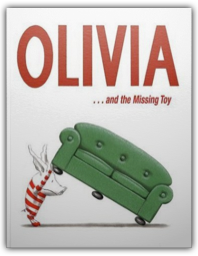
Olivia, like many young pigs, experiences life very intensely. She is utterly obsessed with having her mother make her a red soccer shirt (even though the team color is green), until, of course, she discovers that her favorite toy, her very best toy, is missing, at which point she becomes utterly obsessed with finding it. She looks under the rug, the sofa, and the cat. She shouts accusingly at both her younger brother Ian and her baby brother William, who responds with an unsatisfactory "Wooshee gaga." That night (a dark and stormy one), she hears a horrible sound emanating from behind a closed door, and, in a dramatic scene illuminated by her flaming candelabra and showcased in a fold-out spread, she sees the family dog Perry chewing her favorite toy to bits. As devastating as this is to a passionate young pig, "even Olivia couldn't stay mad forever." She sews up her dismembered toy and falls asleep that very night cozied up with both it and the toy-wrecking Perry. The New Yorker cartoonist and Caldecott Honor artist Ian Falconer (Olivia, 2001) fills his pages with delightful visual stunts, such as the time-lapse drawings of Olivia waiting and waiting and waiting for her mom to sew her soccer shirt and the exaggeratedly scary shadow the toy-eating dog casts on the wall. Olivia fans will rejoice to see their favorite pig being her usual extreme self. (Ages 4 to 8) —Karin Snelson 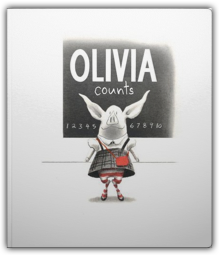
Learning to count to 10 is no chore when accompanied by Olivia, piglet superstar of Ian Falconer's Caldecott Honor Book, Olivia, and Olivia Saves the Circus. Preschoolers will giggle to see reminders of Olivia's mischief in this simple counting book: "one ball, two bows, three pots of paint"... on up to "ten Olivias," pictured in various familiar poses: trying on pantyhose, standing on her head, earnestly jumping rope, sunbathing, etc. Each sturdy page of this small, square board book provides a backdrop of white on which our black and white porcine heroine struts, with occasional red accessories. Early learners will also enjoy Olivia's Opposites. (Baby to preschool) —Emilie Coulter 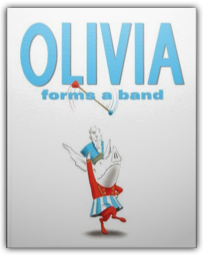
Book Description: 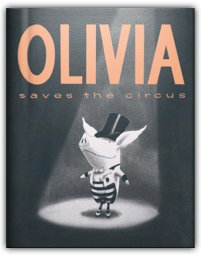
When it comes time to tell the class what she did on her vacation, Olivia isn't at all nervous. In fact, she remembers it quite clearly—she went to the circus, you see. "But when we got there, all the circus people were out sick with ear infections." What are the odds? But the show must go on! Fortunately, Olivia jumps right in to help out—riding elephants, posing as the Tattooed Lady (she draws on the pictures with a marker), taming lions, walking tightropes, juggling, clowning around, and more. In a marvelous fold-out, four-panel spread, our porcine heroine even reigns supreme as the Queen of the Trampoline. "And that's how I saved the circus. And now I am famous." Olivia looks proud. Her teacher looks mad. Ian Falconer shines in this dryly hilarious sequel to his 2001 Caldecott Honor Book Olivia. The charcoal and gouache illustrations perfectly capture Olivia's earnest expressions. Be prepared to be charmed anew! (Ages 4 to 8) —Karin Snelson |

My Library
Collection Total:
1390 Items
1390 Items
Last Updated:
Mar 22, 2009
Mar 22, 2009

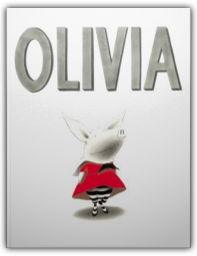
 Made with Delicious Library
Made with Delicious Library